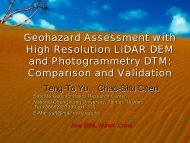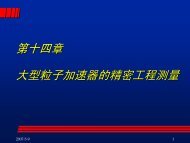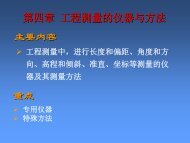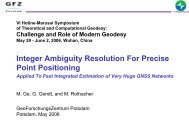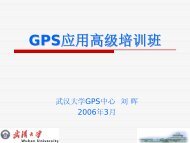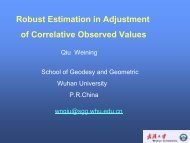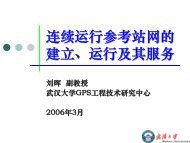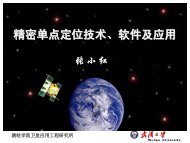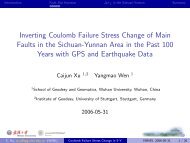ESA's gravity field mission GOCE and beyond
ESA's gravity field mission GOCE and beyond
ESA's gravity field mission GOCE and beyond
- No tags were found...
You also want an ePaper? Increase the reach of your titles
YUMPU automatically turns print PDFs into web optimized ePapers that Google loves.
ESA’s <strong>gravity</strong> <strong>field</strong> <strong>mission</strong><strong>GOCE</strong> <strong>and</strong> <strong>beyond</strong>Roger HaagmansMission Science DivisionEuropean Space AgencyIV Hotine-Marussi Symposium, Wuhan 29 May - 2 June 2006
• ESA’s Living Planet Programme• <strong>GOCE</strong> <strong>mission</strong> status• Swarm <strong>mission</strong> <strong>and</strong> <strong>gravity</strong> <strong>field</strong> potential• Studies related to future ideasIV Hotine-Marussi Symposium, Wuhan 29 May - 2 June 2006
ESA’s Living Planet ProgrammeLiving Planet ProgrammeEarth ExplorerResearch drivenEarth WatchService drivenCoreMissionsOpportunityMissionsEUMETSATGMESEarth<strong>gravity</strong><strong>field</strong>Globalwind<strong>field</strong>Aerosolcloudradiationinteraction<strong>GOCE</strong>2007ADM-Aeolus2008EarthCARE2012Variationin ice sheetthicknessSoilmoisture &oceansalinityEarth’smagnetic<strong>field</strong> & itsevolution intimeCryoSAT 22009SMOS2007Swarm2010MSGMTGEPSPost EPSCall for ideas for next ExplorerCore Mission:Evaluation finishedIV Hotine-Marussi Symposium, Wuhan 29 May - 2 June 2006Sentinel 1-5http://www.esa.int/esaLP
ESA’s Living Planet ProgrammeLiving Planet ProgrammeEarth ExplorerResearch drivenEarth WatchService drivenCoreMissionsOpportunityMissionsEUMETSATGMESBIOMASSTRAQPREMIERFLEXA-SCOPECoReH2O-to take global measurements of forest biomass.-TRopospheric composition <strong>and</strong> Air Quality-PRocess Exploration through Measurements of Infrared <strong>and</strong>millimetre-wave Emitted Radiation.-FLuorescence EXplorer – to observe global photosynthesis.-Advanced Space Carbon <strong>and</strong> Climate Observation of PlanetEarth-Cold Regions Hydrology High-resolution Observatory.Pre-phase A studiesIV Hotine-Marussi Symposium, Wuhan 29 May - 2 June 2006
• ESA’s Living Planet Programme• <strong>GOCE</strong> <strong>mission</strong> status• Swarm <strong>mission</strong> <strong>and</strong> <strong>gravity</strong> <strong>field</strong> potential• Studies related to future ideasIV Hotine-Marussi Symposium, Wuhan 29 May - 2 June 2006
Scientific Context of MissionSolid Earth Physicsanomalous density structureof lithosphere <strong>and</strong> uppermantle, <strong>and</strong> better constraintsfor modelling of Earth’sinteriorOceanographydetermination of dynamicocean topography, absoluteocean circulation, <strong>and</strong> mass<strong>and</strong> heat transferIce Sheetsimproved knowledge ofice sheet mass balance<strong>and</strong> from the above, improved rateestimates of Sea Level RiseIV Hotine-Marussi Symposium, Wuhan 29 May - 2 June 2006Geodesyunified height systems,“levelling by GPS” (i.e.orthometric heights)
Mission Requirements• To determine the Earth’s <strong>gravity</strong> <strong>field</strong> with anaccuracy of 1 mGal (1 mGal = 10 -5 m/s 2 )• To determine the geoid (= equipotentialsurface for a hypothetical ocean at rest) with 1-2 cm accuracy• achieve this at a resolution or half wavelengthscale of 100 km (approx. degree <strong>and</strong> order200)IV Hotine-Marussi Symposium, Wuhan 29 May - 2 June 2006
Measurement Approach<strong>GOCE</strong> combines satellite gradiometry <strong>and</strong>high-low satellite-to-satellite tracking in alow Earth orbit of ± 250km altitude, withunique continuous operation of Drag-FreeAttitude Control to combat the effects ofair dragEGM96 gradients; Mean value removed• Electrostatic Gravity Gradiometer(EGG):Measures the components of the<strong>gravity</strong> gradient tensor in thegradiometer reference frame within ab<strong>and</strong>width of 5-100 mHz• Satellite-to-Satellite TrackingInstrument (SSTI):Geodetic-quality GPS receiver allowsorbit reconstitution with an accuracy of~1 cm in all directions <strong>and</strong> recovery oflower order harmonicsIV Hotine-Marussi Symposium, Wuhan 29 May - 2 June 2006
High-Level Processing FacilityAIUB: Astronomical InstituteUniversity BernCNES: Centre Nationaled‘Etudes Spatiale,ToulouseFAE/A&S: Delft University ofTechnology, Faculty ofAerospace EngineeringGFZ:GeoForschungsZentrumPotsdamIAPG: Institute of Astronomical<strong>and</strong> Physical Geodesy,Techn. University MunichITG:Institute for TheoreticalGeodesy, Univ. BonnPOLIMI: Politecnico di MilanoSRON: National Institute forSpace Research, TheNetherl<strong>and</strong>sTUG:Institute of Navigation<strong>and</strong> Satellite Geodesy,Techn. University GrazUCPH: Department ofGeophysics, UniversityCopenhagenFAE/A&SITGAIUBCNESSRONUCPHPOLIMIIAPGGFZTUGIV Hotine-Marussi Symposium, Wuhan 29 May - 2 June 2006
Level 2 Data Products• Global Earth <strong>gravity</strong> potential modelled asspherical harmonic series (incl. coefficients<strong>and</strong> error estimates)• Variance-covariance matrix of final <strong>GOCE</strong>Earth <strong>gravity</strong> <strong>field</strong> model• Global ground-referenced gridded values of:– geoid heights (Earth geoid map)– <strong>gravity</strong> anomalies (Earth <strong>gravity</strong> map)– geoid slopesIV Hotine-Marussi Symposium, Wuhan 29 May - 2 June 2006
Main Technical Challenges Highest sensitivityaccelerometers in spaceCHAMP:∼10 -9 ms -2GRACE:∼10 -10 ms -2<strong>GOCE</strong>: ∼10 -12 ms -2 Ultra-stable Carbon-Carbonstructure with superior thermoelasticstability properties inthe MBW∼ 1 pm over 200 s∼10 mK over 200 s Continuous operation <strong>and</strong>modulation of highly accurateion thrusters with high thrust<strong>and</strong> thrust gradient dem<strong>and</strong>sIV Hotine-Marussi Symposium, Wuhan 29 May - 2 June 2006
One-Axis GradiometerOAGY: Y-directionCarbon-Carbon ArmStructurewith Accelerometer Pair,including magneticshielding <strong>and</strong> connectorsIV Hotine-Marussi Symposium, Wuhan 29 May - 2 June 2006
Gradiometer Structural ModelIV Hotine-Marussi Symposium, Wuhan 29 May - 2 June 2006
Impact of launch delay on altitudeAs solar activity <strong>and</strong> consequently atmospheric drag increasealtitude adjustments become necessaryIV Hotine-Marussi Symposium, Wuhan 29 May - 2 June 2006
Consequence of Launch DelayLaunch in May 2007• MOP 1 at an altitude of 240 km <strong>and</strong> MOP 2 at an altitude of 250 kmMission performance: Geoid accuracy up to 1 cmGravity anomaly well below 1 mgalLaunch in September 2007• MOP 1 at an altitude of 250 km <strong>and</strong> MOP 2 at an altitude 260 kmMission performance: Geoid accuracy of up to 1.5 cmGravity anomaly below 1 mgalLaunch in January 2008Performance indicated at degree 200 (100km spatial resolution)• MOP 1 at an altitude of 255 km <strong>and</strong> MOP 2 at an altitude 265 kmMission performance: Geoid accuracy of up to 2 cmGravity anomaly 1 mgalIV Hotine-Marussi Symposium, Wuhan 29 May - 2 June 2006
Level 2: Simulated Product AccuracyIV Hotine-Marussi Symposium, Wuhan 29 May - 2 June 2006
Meetings <strong>and</strong> Studies• 3 rd International <strong>GOCE</strong> User Workshop, planned forNov. 2006 - ESRIN (ESA, SP-627)http://earth.esa.int/goce06/• IUGG XXIV, Perugia, Italy, planned for July 2007• Ongoing Scientific Studies– GSP - Gravity improvement of ocean shelf circulation(underway)– GSP – Combination of Space, airborne, <strong>and</strong> in-situ <strong>gravity</strong>measurements in support of Arctic sea-ice thickness mapping(underway)– <strong>GOCE</strong> Toolbox study (underway)IV Hotine-Marussi Symposium, Wuhan 29 May - 2 June 2006
Announcements of Opportunities• <strong>GOCE</strong> Cal/Val AO: May-July 2003– L1-L2 Processing Facility capability• Data screening (incl. QL analysis for quality control)• Outlier detection• Temporal <strong>gravity</strong> effect removal (e.g. tides)• Assessment of residual uncertainties in instrument data– External calibration of GGT observations– Validation of L1b data products• Planned <strong>GOCE</strong> Data AO: Sept. 2006– Data quality assessment/performance verification– Proposals for scientific data use– Synergies with other platform data• Launch <strong>and</strong> Phase E1 starting Spring 2007 (TBC)IV Hotine-Marussi Symposium, Wuhan 29 May - 2 June 2006
• ESA’s Living Planet Programme• <strong>GOCE</strong> <strong>mission</strong> status• Swarm <strong>mission</strong> <strong>and</strong> <strong>gravity</strong> <strong>field</strong> potential(Christian Gerlach TUM <strong>and</strong> Pieter Visser DUT)Studies related to future ideasIV Hotine-Marussi Symposium, Wuhan 29 May - 2 June 2006
The Swarm MissionPrimary Objectives• core dynamics, geodynamo processes,<strong>and</strong> core-mantle interaction• lithospheric magnetisation• 3-D electrical conductivity of the mantleTheme: Earth’s InteriorUnique view view “inside”the the Earth from from space for forcore, mantle & crust• electric currents in magnetosphere <strong>and</strong>ionosphereTheme: Physical ClimateSun’s influence withinEarth systemSecondary Objectives• magnetic forcing of the upper atmosphere• magnetic signature related to ocean circulationcorrectionIV Hotine-Marussi Symposium, Wuhan 29 May - 2 June 2006
Swarm Satellite & ConstellationAccelerometerGPS PatchAntennaslaunch after 1.5 yr after 3 yrs after 4.5 yrslaunch after 4.5 yearsred (C) 530 km 500 kmyellow (A,B) 450 km 300 kmIV Hotine-Marussi Symposium, Wuhan 29 May - 2 June 2006
Swarm <strong>and</strong> Gravity - ConstellationObservation: GPS-baseline between satellitesGeometry:GRACE A-B:Swarm A-B:Swarm A-C:along-track (KBR, scalar)cross-track (GPS, vector)~ radial (GPS, vector)IV Hotine-Marussi Symposium, Wuhan 29 May - 2 June 2006
Swarm <strong>and</strong> GravityUse of GPS-Baseline Observations(1) Error propagation: incination functions using transfercoefficients for potential gradientsV , V ,xyVzFor short baselines:ΔV/ || Δx||≈Vx(2) Full simulation: energy integral for potential differencesGRACE 1-2Swarm A-BSwarm A-CΔV along-trackΔV cross-trackΔV radialIV Hotine-Marussi Symposium, Wuhan 29 May - 2 June 2006
GPS inter-satellite baseline test: GRACEHigh-pass filtered GRACE inter-satellite rangingFrom KBRFrom GPSEmpirical rangeerrors(GPS vs. KBR)σσσalongcrossradial===2.12.02.7mmmmmmExpected rangerateaccuracy:σ ≈10 −2mm/sIV Hotine-Marussi Symposium, Wuhan 29 May - 2 June 2006
SH-Error CharacteristicsAlong-track simulations vs. real data (GRACE)(1)Inclination functionsCovariance Matrix(2)error propagationEnergy integralEIGEN-GRACE02s (GFZ)full simulationIV Hotine-Marussi Symposium, Wuhan 29 May - 2 June 2006
Gravity Field Gradientsalong-trackcross-trackradialIV Hotine-Marussi Symposium, Wuhan 29 May - 2 June 2006
SH-Error Characteristicsfrom Gradients in x,y <strong>and</strong> z(1)along-trackcross-trackalong + crossradialIV Hotine-Marussi Symposium, Wuhan 29 May - 2 June 2006
SH-Error Characteristicsfrom Different Observation Directions(2)along-trackcross-trackalong + crossradialIV Hotine-Marussi Symposium, Wuhan 29 May - 2 June 2006
Simulation results: 1 MonthDegree RMSKaula10 -1CHAMP10 -2][m10 -3crossalongradial: GRACE & <strong>GOCE</strong>10 -410 0 s h-de gre ecross + alongcross & along: Swarm A-B & GRACE10 -5KBR10 -610 20 30 40 50 60 70IV Hotine-Marussi Symposium, Wuhan 29 May - 2 June 2006
Simulation results: 1 MonthDegree RMSKaula10 -1CHAMP10 -2][m10 -3cross10 0 s h-de gre ealongSwarmradialA-B <strong>and</strong> A-C10 -4cross + alongGRACE10 -5KBR10 -610 20 30 40 50 60 70IV Hotine-Marussi Symposium, Wuhan 29 May - 2 June 2006
Remarks• Gravity <strong>field</strong> recovery with Swarm is possible• Continuation of decade of <strong>gravity</strong> <strong>field</strong> mappingpossible (but, with reduced accuracy)• Radial component most sensitive at end of <strong>mission</strong>(but, bad visibility)• Simulation must include full GPS-simulation(visibility)• Realistic error estimates for GPS?• Different analysis methods possible (not necessarilyenergy integral)IV Hotine-Marussi Symposium, Wuhan 29 May - 2 June 2006
• ESA’s Living Planet Programme• <strong>GOCE</strong> <strong>mission</strong> status• Swarm <strong>mission</strong> <strong>and</strong> <strong>gravity</strong> <strong>field</strong> potential• Studies related to future ideasIV Hotine-Marussi Symposium, Wuhan 29 May - 2 June 2006
Studies Recently Performed• Gravity Gradient sensor technology for futureplanetary <strong>mission</strong>s ESA ITT AO/1-3829/01/NL/ND(MEMS, Atom interferometry)University of Nantes: Christophe Sotin <strong>and</strong> his teamUniversity of Twente: Jaap Flokstra, Remco Wiegerink,Herman Hemmes, Javier Sese, Reinder Cuperus• Laser Doppler Interferometry Mission fordetermination of the Earth’s Gravity FieldMarco PISANI (IMGC), Andrea Milani (UniPi), RobertoSabadini (UniMi), Federica Migliaccio, F. Sansò (PoliMi)Alcatel Alenia Space Italia S.p.A. Stefano Cesare <strong>and</strong> teamIV Hotine-Marussi Symposium, Wuhan 29 May - 2 June 2006
SSI Mission Reference Parameters Summary• Orbit altitude: h = 325 km, circular• Orbit inclination: i = 96.78°(sunsynchronous)• Longitude of ascending node: Ω = RA ±90° (dusk-dawn/dawn-dusk orbit)• Measurement phase duration: 6 years• Satellite number, arrangement: 2 satellitesmoving along the same orbital path• Inter-satellite distance: d = 10 kmIV Hotine-Marussi Symposium, Wuhan 29 May - 2 June 2006
Measurement <strong>and</strong> control elements of the SSI <strong>mission</strong>IV Hotine-Marussi Symposium, Wuhan 29 May - 2 June 2006
Non-gravitational acceleration measurement requirementsAccelerometer noise spectraldensity (in-line axis): levelcomparable to <strong>GOCE</strong> but to beoptimized in a lower spectral b<strong>and</strong>.Accelerometer absolute scale factorknowledge accuracy ≤ 210 -4 (tentimes better than in <strong>GOCE</strong>)Absolute scale factor stability alsomore dem<strong>and</strong>ing than in <strong>GOCE</strong>.IV Hotine-Marussi Symposium, Wuhan 29 May - 2 June 2006
Satellite-satellite distance measurement requirementsLaser interferometermeasurement error:≤ 1.2 nm 1σ in MBWSatellite orientationrelative to laser beammeasurement errorLaser beam pointingtowards retroreflectoron satellite 2IV Hotine-Marussi Symposium, Wuhan 29 May - 2 June 2006
SSI Mission Control System ElementsThe Linear Motion Control in charge of: satellite formation keeping (relativeposition control) drag-free control for each spacecraftThe Angular Motion Control in charge of: spacecraft angular acceleration,angular rate <strong>and</strong> attitude controlBeam Steering Control in charge of: pointing of the laser beam emittedby satellite 1 to the satellite 2IV Hotine-Marussi Symposium, Wuhan 29 May - 2 June 2006
Future Concepts ?GSP - Mass distribution <strong>and</strong> mass transports inthe Earth system (ITT in prep.)Courtesy: C. BartonIV Hotine-Marussi Symposium, Wuhan 29 May - 2 June 2006



